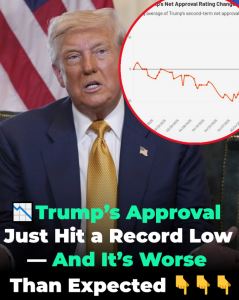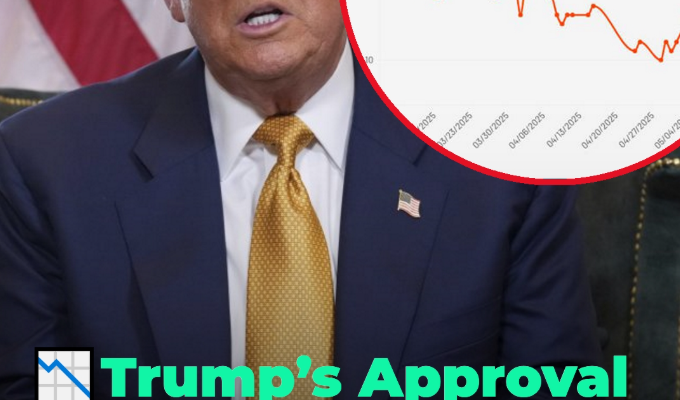The numbers seemed to flash across every news broadcast at once, as though the country itself were holding its breath. For weeks, pollsters had warned of a slump in public opinion, but few expected it to reach this depth. President Donald Trump’s approval rating had fallen to its lowest point of his second term, and the announcement landed with the weight of a hammer on a nation already rattled by inflation, cultural unrest, and a general sense of political fatigue.
Thirty-seven percent. That was the figure Gallup delivered in mid-August 2025, placing Trump’s standing with the public at nearly the lowest point of his political career. Only once before, in the waning days of his first administration, had he touched thirty-four percent. Now, after clawing his way back into office, he finds himself once more fighting the gravity of public disapproval. The story behind the number is more complex than any single poll, but it carries an unmistakable message: America is weary, fractured, and increasingly skeptical of its leader.
The decline was not uniform. Among Republicans, Trump still held strong, boasting approval near ninety percent. The base has always been his anchor, and in times of turbulence, it has carried him through storms that would have sunk other politicians. But the erosion among independents told a more troubling story. In 2020, when Trump left office the first time, independents represented both his Achilles’ heel and his last hope. Now, five years later, their disapproval had hardened. Less than three in ten said they trusted his leadership, a collapse that mirrored the depths of his weakest moments. For a president seeking to project strength, this was a blow that cut deep.
What drove the numbers downward was not a single scandal or crisis but a steady accumulation of frustrations. Inflation remained the invisible tax eating away at household budgets. Even with the rate hovering around three percent, voters felt the squeeze most acutely at the grocery store and at the gas pump. The tariffs Trump re-imposed on Asian and European imports rattled business owners and stirred fears of recession. Wall Street grew jittery, and Main Street families saw little relief. Voters may not follow macroeconomic charts, but they know when the cost of milk and bread rises faster than their paychecks.
Immigration, once Trump’s strongest rallying cry, also became a source of division. The president’s insistence on mass deportations struck a chord with some, but when stories surfaced of longtime residents—people without criminal records—being rounded up and expelled, sympathy waned. Hispanic voters, many of whom had once leaned toward Trump’s promise of order and security, began to drift away. His approval among Latinos plummeted into the low thirties, echoing the broader collapse among independents. What had once been a winning wedge issue now threatened to fracture his coalition.
Overlaying these domestic troubles were questions of foreign policy and trust. Trump’s renewed outreach to Russia unsettled moderates and even some conservatives. A majority of Americans, including a notable slice of his own party, believed he had grown too close to Vladimir Putin. His overtures toward ending the war in Ukraine, though framed as diplomacy, were criticized as concessions that risked abandoning an ally. In ordinary times, foreign policy might not dominate voter concerns, but in a climate of unease, it fed into a larger narrative of mistrust.
The president’s leadership style, always combative and unilateral, added fuel to the fire. In the first months of his second term, Trump signed dozens of executive orders covering everything from gender recognition laws to cryptocurrency regulation. For supporters, this was evidence of a president taking decisive action. For critics and moderates, it looked like overreach, a man governing by decree rather than consensus. The perception of heavy-handedness chipped away at public confidence, reinforcing the image of a leader unwilling to compromise.
The political consequences of these shifts are already being mapped. Analysts warn that Republicans could lose control of the House in 2026 if the current trajectory holds. Congressional candidates live and die by the president’s popularity, and Trump’s slump among independents is a warning siren. “Adios,” one CNN data expert declared bluntly, predicting that the toxic numbers among moderates would doom Republicans in swing districts.
The larger question is what all this means for a country already staggering under the weight of division. Approval ratings do not exist in a vacuum—they shape public mood, policy momentum, and international perception. A president at his weakest risks not only losing legislative battles but also undermining faith in governance itself. For America’s allies, Trump’s weakness raises doubts about stability. For its adversaries, it signals opportunity. And for ordinary citizens, it reinforces a gnawing sense of drift.
Yet for all the bleakness of the numbers, Trump’s core supporters remain defiantly loyal. To them, the polls are just another manifestation of a biased media and out-of-touch elites. They see in his struggles not weakness but persecution, proof that he is still fighting a system stacked against him. This paradox—weak with the middle, strong with the base—is the essence of the Trump era. It is a strength that sustains him but also a cage that prevents him from expanding his reach.
The nation, meanwhile, is caught in a cycle of fatigue and frustration. Approval ratings are only one barometer of national mood, but they mirror the conversations happening around dinner tables and in workplaces. People wonder aloud why groceries cost so much, why politics feels so bitter, why leadership seems absent. Some cling to Trump’s promises, others recoil, but all share the sense that something fundamental has been unsettled.
Whether the president can reverse this trend is uncertain. History suggests that once independents turn away, it is nearly impossible to win them back. A sudden economic upswing or a foreign policy victory could shift the narrative, but the underlying mistrust may be too deep. If the trajectory continues, Trump could enter the next election cycle as one of the weakest incumbents in modern history.
For now, the numbers stand as a stark symbol. A country in turmoil. A president at his lowest ebb. A people grappling with the dissonance between loyalty and disillusion. The approval rating is not just a measure of Trump’s standing—it is a mirror reflecting America’s exhaustion.
And as the headlines continue to roll, the number will be repeated endlessly: thirty-seven percent. It is not just a statistic but a story, one that tells of fading confidence, restless citizens, and a presidency straining under the weight of its own contradictions.


